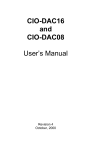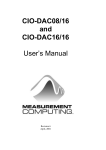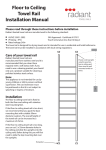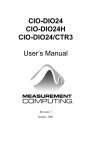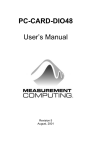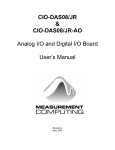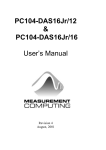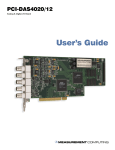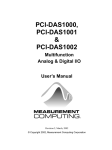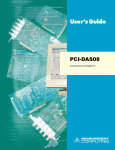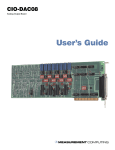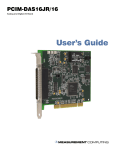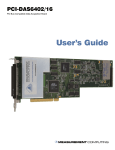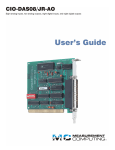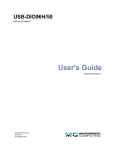Download Word Pro - HM CIO-DAC##
Transcript
CIO-DAC08-I and CIO-DAC16-I User’s Manual Revision 3 October, 2000 MEGA-FIFO, the CIO prefix to data acquisition board model numbers, the PCM prefix to data acquisition board model numbers, PCM-DAS08, PCM-D24C3, PCM-DAC02, PCM-COM422, PCM-COM485, PCM-DMM, PCM-DAS16D/12, PCM-DAS16S/12, PCM-DAS16D/16, PCM-DAS16S/16, PCI-DAS6402/16, Universal Library, InstaCal, Harsh Environment Warranty and Measurement Computing Corporation are registered trademarks of Measurement Computing Corporation. IBM, PC, and PC/AT are trademarks of International Business Machines Corp. Windows is a trademark of Microsoft Corp. All other trademarks are the property of their respective owners. Information furnished by Measurement Computing Corp. is believed to be accurate and reliable. However, no responsibility is assumed by Measurement Computing Corporation neither for its use; nor for any infringements of patents or other rights of third parties, which may result from its use. No license is granted by implication or otherwise under any patent or copyrights of Measurement Computing Corporation. All rights reserved. No part of this publication may be reproduced, stored in a retrieval system, or transmitted, in any form by any means, electronic, mechanical, by photocopying, recording or otherwise without the prior written permission of Measurement Computing Corporation. Notice Measurement Computing Corporation does not authorize any Measurement Computing Corporation product for use in life support systems and/or devices without the written approval of the President of Measurement Computing Corporation Life support devices/systems are devices or systems which, a) are intended for surgical implantation into the body, or b) support or sustain life and whose failure to perform can be reasonably expected to result in injury. Measurement Computing Corp. products are not designed with the components required, and are not subject to the testing required to ensure a level of reliability suitable for the treatment and diagnosis of people. (C) Copyright 2000 Measurement Computing Corp. HM CIO-DAC##-I.lwp TABLE OF CONTENTS 1 INTRODUCTION . . . . . . . . . . . . . . . . . . . . . . . . . . . . . . . . . . . . . . . . . . . . . . 1 2 SOFTWARE INSTALLATION . . . . . . . . . . . . . . . . . . . . . . . . . . . . . . . . 1 3 HARDWARE INSTALLATION . . . . . . . . . . . . . . . . . . . . . . . . . . . . . . . . 2 3.1 Initial Board Setup . . . . . . . . . . . . . . . . . . . . . . . . . . . . . . . . . . . . . . . . . . 2 3.2 Selecting the Base Address . . . . . . . . . . . . . . . . . . . . . . . . . . . . . . . . . . 2 3.3 Installing the CIO-DAC##-I in the Computer . . . . . . . . . . . . . . . . 3 3.4 Cabling to the CIO-DAC##-I . . . . . . . . . . . . . . . . . . . . . . . . . . . . . . . . 4 3.5 Testing the Installation . . . . . . . . . . . . . . . . . . . . . . . . . . . . . . . . . . . . . . 4 3.6 Signal Connection- Current Loop . . . . . . . . . . . . . . . . . . . . . . . . . . . . 5 3.7 Connector Diagram . . . . . . . . . . . . . . . . . . . . . . . . . . . . . . . . . . . . . . . . . 6 4 REGISTER ARCHITECTURE . . . . . . . . . . . . . . . . . . . . . . . . . . . . . . . . . 7 5 SPECIFICATIONS . . . . . . . . . . . . . . . . . . . . . . . . . . . . . . . . . . . . . . . . . . . . 10 This page is blank. 1 INTRODUCTION The CIO-DAC-series boards are available in either eight-channel or 16-channel versions and with either voltage or current (I) outputs. In this manual, the current output (I) boards are described and are referred to generically as CIO-DAC##-I unless a specific board is being described. Analog current outputs are from dual-DAC AD7237s with each output buffered by 2N2222 transistors. The analog outputs are controlled by writing a digital control and data word as two bytes (actually a data byte and a data nibble along with a nibble containing channel information) to two control registers. The control register is double-buffered so a DAC's output is not updated until both bytes (first low byte, then high byte) are written. The CIO-DAC08-I and CIO-DAC16-I have a bank of nine address DIP switches. (See Figure 2-1.) There are no other switches or jumpers. 2 SOFTWARE INSTALLATION An installation program labeled InstaCal™ is on the disk shipped with the board. This program will guide you through board configuration and switch settings. Refer to the Software Installation Manual for complete instructions regarding installing and using InstaCal. If you decide not to use InstaCal as a guide, the information required for configuring the board is provided in the following section. 1 3 HARDWARE INSTALLATION 3.1 Initial Board Setup The CIO-DAC##-I has only one bank of switches for setting the base address which must be set before installing the board in your computer. The InstaCal calibration and test program included with the CIO-DAC##-I will show how these switches are to be set. Run the program before you open your computer. The CIO-DAC##-I is setup at the factory as follows: BASE ADDRESS 300h (768 decimal) Same as data sheet. 3.2 Selecting the Base Address Unless there is already a board in your system that uses address 300h (768 decimal), leave the switches as they are set at the factory. In the following examples, the board (CIO-DAC08-I or CIO-DAC16-I) are set for a base address of 300h (768 decimal). NOTE: Use the white numbers on the PCB, not those on the switch. Certain address are used by the PC, others are free and can be used by the CIO-DAC##-I and other expansion boards. 9 8 7 6 5 4 3 2 BASE ADDRESS SWITCH Address 300H shown 1 SWITCH HEX 9 200 8 100 7 80 6 40 5 20 4 10 3 8 2 4 1 2 Figure 3-1. Base Addresses- CIO-DAC08-I, CIO-DAC16-I 2 HEX RANGE 000-00F 020-021 040-043 060-063 060-064 070-071 080-08F 0A0-0A1 0A0-0AF 0C0-0DF 0F0-0FF 1F0-1FF 200-20F 210-21F 238-23B 23C-23F 270-27F 2B0-2BF Table 3-1. PC I/O Addresses FUNCTION HEX RANGE 8237 DMA #1 2C0-2CF 8259 PIC#1 2D0-2DF 8253 TIMER 2E0-2E7 8255 PPI (XT) 2E8-2EF 8742 CONTROLLER (AT) 2F8-2FF CMOS RAM & NMI MASK 300-30F DMA PAGE REGISTERS 310-31F 8259 PIC #2 (AT) 320-32F NMI MASK (XT) 378-37F 8237 #2 (AT) 380-38F 80287 NUMERIC CO-P (AT) 3A0-3AF HARD DISK (AT) 3B0-3BB GAME CONTROL 3BC-3BB EXPANSION UNIT (XT) 3C0-3CF BUS MOUSE 3D0-3DF ALT BUS MOUSE 3E8-3EF PARALLEL PRINTER 3F0-3F7 EGA 3F8-3FF FUNCTION EGA EGA GPIB (AT) SERIAL PORT SERIAL PORT PROTOTYPE CARD PROTOTYPE CARD HARD DISK (XT) PARALLEL PRINTER SDLC SDLC MDA PARALLEL PRINTER EGA CGA SERIAL PORT FLOPPY DISK SERIAL PORT The CIO-DAC##-I BASE ADDRESS switch can be set for address in the range of 000-3FEh so it should not be hard to find a free address area for your board. If not using IBM prototyping cards or any other board which occupies these addresses, 300-31Fh are free to use. Address not specifically listed, such as 390-39Fh, are free. 3.3 Installing the CIO-DAC##-I in the Computer 1. Turn PC power off. 2. Remove the cover of your computer. Please be careful not to dislodge any of the cables installed on the boards in your computer as you slide the cover off. 3. Locate an empty expansion slot in your computer. 4. Push the board firmly down into the expansion bus connector. If it is not seated fully it can fail to work and could short circuit the PC bus power onto a PC bus signal. This could damage the motherboard in your PC as well as the board. 3 3.4 Cabling to the CIO-DAC##-I The CIO-DAC##-I connector is accessible through the PC/AT expansion bracket. The connector is a standard 37-pin D-type male connector. A mating female connector, such as the C37FF-2, is available from Measurement Computing. Several cabling and screw termination options are available from Measurement Computing. DFCON-37 C37FF-2 C37FFS-5 CIO-MINI37 CIO-TERMINAL CIO-SPADE 50 D connector, D shell and termination pins to construct your own cable 2 foot (and longer) ribbon cable with 37 pin D female connectors 5 foot shielded round cable with molded ends housing 37-pin female connectors. Also in 10 ft. 37-position, 4 X 4-in. screw terminal board 4 X 16-in. screw terminal board with on-board prototyping area. A screw terminal board that accepts spade lugs with on-board area for prototyping circuitry. 3.5 Testing the Installation You can test the installation of the CIO-DAC##-I using InstaCal. Select the Test option to vary the output voltages and monitor them with a Volt Meter. 4 3.6 Signal Connection- Current Loop The basic CIO-DAC##-I current output circuit is shown in Figure 3-2. Loop power is from an external power supply. The supply voltage is from 6V to 36V, with 24V or 36V being typical choices. 4-20mA Control + - LLGND Figure 3-2. Basic Current Loop The 4 to 20 mA loop can be configured with either a floating power supply (Figure 3-3) or a floating load (Figure 3-4). 4-20mA Control Board 4-20mA Control + Floating Supply 4-20mA Control Board 4-20mA Control Load + + + - - - Supply Grounded Load LLGND LLGND Figure 3-3. I-Loop, Floating Supply Figure 3-4. I-Loop, Floating Load 5 3.7 Connector Diagram The CIO-DAC##-I connector is a 37-pin D-type connector accessible from the rear of the PC through the expansion backplate (Figures 3-5, 3-6). The connector accepts female 37-pin, D-type connectors, such as those on the C37FF-2, 2-foot cable with connectors. If frequent changes to signal connections or signal conditioning is required, refer to the information on the CIO-TERMINAL, CIO-SPADE50 and CIO-MINI37 screw terminal boards in the Measurement Computing catalog. -12V 19 GND 18 +12V 17 D/A 15 OUT 16 D/A 14 OUT 15 D/A 13 OUT 14 D/A 12 OUT 13 D/A 11 OUT 12 D/A 10 OUT 11 D/A 9 OUT 10 D/A 8 OUT 9 D/A 7 OUT 8 D/A 6 OUT 7 D/A 5 OUT 6 D/A 4 OUT 5 D/A 3 OUT 4 D/A 2 OUT 3 D/A 1 OUT 2 D/A 0 OUT 1 37 36 35 34 33 32 31 30 29 28 27 26 25 24 23 22 21 20 GND +5V LLGND LLGND LLGND LLGND LLGND LLGND LLGND LLGND LLGND LLGND LLGND LLGND LLGND LLGND LLGND LLGND Figure 3-5. CIO-DAC16-I Connector Figure 3-6. CIO-DAC08-I Connector 6 4 REGISTER ARCHITECTURE The CIO-DAC##-I is a simple board to understand. All control and data is read/written with simple I/O read and write commands. No interrupt or DMA control software is required. Thus, the board's outputs are easy to control directly from BASIC, C or PASCAL. The CIO-DAC##-I has two control and analog output registers. The first address, or BASE ADDRESS, is determined by the setting of a bank of switches on the board. The register descriptions all follow the format: 7 A7 6 A6 5 A5 4 A4 3 A3 2 A2 1 A1 0 A0 the numbers along the top row are the bit positions within the 8-bit byte and the numbers and symbols in the bottom row are the functions associated with each bit. To write to or read from a register in decimal or HEX, the following weights apply: BIT POSITION 0 1 2 3 4 5 6 7 Table 4-1. Register Bit Weights DECIMAL VALUE 1 2 4 8 16 32 64 128 7 HEX VALUE 1 2 4 8 10 20 40 80 In summary form, the registers and their function are listed in the following table. Table 4-2. Register Map ADDRESS BASE + 0 BASE + 1 WRITE FUNCTION D/A Least Significant Byte D/A Most Significant Nibble and Channel address READ FUNCTION None None These two registers control all of the DACs on the CIO-DAC##-I. The first register, BASE + 0, contains the least significant eight bits of D/A code and is written first. BASE + 0 7 D5 6 D6 5 D7 4 D8 3 D9 2 D10 1 D11 0 D12 (LSB) The second register contains the most significant four bits of D/A code and the four bits that determine which channel the data will be sent to. This register is written to second. A write to this register updates the output of the selected D/A with all 12 bits of the D/A code contained in the two registers. BASE + 1 7 CH3 6 CH2 5 CH1 4 CH0 3 D1 (MSB) 2 D2 1 D3 0 D4 D12: 1 Data bits CH3:0 Channel value (0000 = channel 0, 0101 = channel 5, etc.) Updating the output of a particular DAC channel is a matter of calculating the code for the output value desired and combining it with the channel number. To calculate the data code, you first select the output you desire, then apply a transfer function to that value. The transfer function for code = output is: FSI / 4095 * CODE = Current Out +4 mA or CODE = Current Out - 4 / 16 * 4095 Full scale current (FSI) is not 20 mA, it is 20 - 4 or 16 mA. Use this in the equation above. For Example: If CODE = 0, current output = 4 mA If CODE = 4095, current output = 20 mA 8 After calculating the code required for the D/A data, combine it with the code required for the channel number. For example, to set the output on channel 3 to 11.890625mA: CODE = 11.890625mA - 4 / 16 * 4095 = 2020 The digital code for 2020 is 0111 1110 0100. To this, you would add the value for channel 3 (0011) as the upper nibble for the second register. The end result is 0011 0111 1110 0100. This is written to the registers as: BASE + 0: BASE + 1: 228 (or E4 hex) 55 (or 37 hex) 9 5 SPECIFICATIONS POWER CONSUMPTION CIO-DAC16-I +5V supply +12V supply −12V supply CIO-DAC08-I +5V supply +12V supply −12V supply 320 mA typical, 500 mA max 150 mA typical, 190 mA max 100 mA typical, 130 mA max 320 mA typical, 500 mA max 75 mA typical, 100 mA max 50 mA typical, 65 mA max ANALOG OUTPUT D/A type Resolution Number of channels CIO-DAC16-I CIO-DAC08-I Output Range Voltage compliance AD7237 12 bits 16 Current Outputs 8 Current Outputs 4 to 20mA 6 to 36V D/A pacing Data transfer Software paced Software Offset error Gain error Differential nonlinearity Integral nonlinearity Monotonicity Adjustable to zero Adjustable to zero ±1 LSB max ±1 LSB max Guaranteed monotonic to 15 bits over temperature ±15 ppm/°C max ±5 ppm/°C max ±3 ppm/°C max System dependant 12 µs typ, 19 µs max Double buffered output latches DAC output state on power up and reset undefined Gain drift (DAC) Bipolar offset drift (DAC) Unipolar offset drift (DAC) Throughput Settling time (Full scale step to .01%) Miscellaneous ENVIRONMENTAL Operating temerature range Storage temerature range Humidity 0 to 70°C −40 to 100°C 0 to 90% non-condensing 10 EC Declaration of Conformity We, Measurement Computing Corp., declare under sole responsibility that the product: CIO-DAC16-I CIO-DAC08-I Part Number ISA-Type Current output card ISA-Type Current output card Description to which this declaration relates, meets the essential requirements, is in conformity with, and CE marking has been applied according to the relevant EC Directives listed below using the relevant section of the following EC standards and other normative documents: EU EMC Directive 89/336/EEC: Essential requirements relating to electromagnetic compatibility. EU 55022 Class B: Limits and methods of measurements of radio interference characteristics of information technology equipment. EN 50082-1: EC generic immunity requirements. IEC 801-2: Electrostatic discharge requirements for industrial process measurement and control equipment. IEC 801-3: Radiated electromagnetic field requirements for industrial process measurements and control equipment. IEC 801-4: Electrically fast transients for industrial process measurement and control equipment. Carl Haapaoja, Director of Quality Assurance Measurement Computing Corporation 16 Commerce Boulevard, Middleboro, MA 02346 (508) 946-5100 Fax: (508) 946-9500 E-mail: [email protected] www. measurementcomputing.com
















